Dry garden design focuses on creating beautiful, sustainable landscapes that thrive in low-water conditions. It embraces drought-resistant plants, smart landscaping techniques, and strategic placement to ensure your garden looks great without hefty irrigation needs. This approach not only saves water but also encourages the use of native flora that supports local ecosystems, making it both practical and pleasing to the eye.
Layering Textures and Colors in a Dry Garden

Creating a dry garden is all about playing with textures and colors. The image shows a variety of plants, each with its own unique shape and hue. Notice how the different shades of green, yellow, and brown come together to form a beautiful landscape.
The spiky plants add a dynamic element, while the rounder forms create a sense of balance. This mix of textures makes the garden visually interesting. You can easily incorporate similar plants to achieve this effect in your own space.
Using gravel and stones as ground cover enhances the overall look. They not only help with drainage but also serve as a neutral backdrop that allows the plants to shine. Think about how you can layer these elements to create depth in your garden.
When choosing plants, consider their growth patterns and colors. Grouping plants with similar colors can create a harmonious look, while contrasting colors can add excitement. The key is to have fun and experiment with what works best for your garden.
Utilizing Native Plants in Dry Garden Design
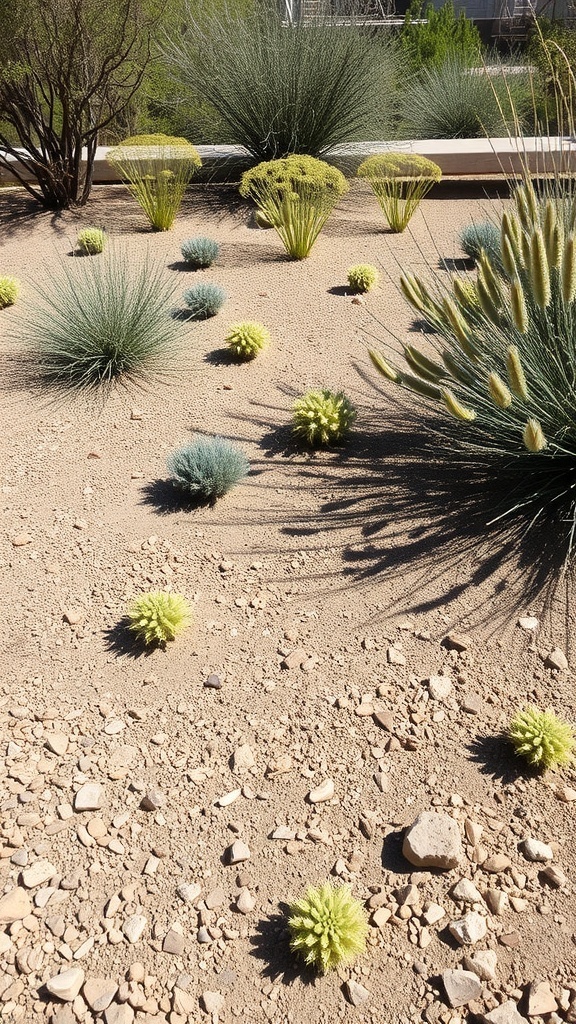
Native plants are a fantastic choice for dry garden design. They thrive in local conditions and require less water than non-native species. This means you can enjoy a beautiful garden while conserving resources.
The image shows a variety of native plants arranged in a sandy landscape. The different textures and colors create a visually appealing scene. Notice how the plants are spaced out, allowing each one to shine while also creating a cohesive look.
Using native plants helps support local wildlife, too. Birds, bees, and butterflies are drawn to these plants, making your garden a lively spot. Plus, they often require less maintenance, giving you more time to relax and enjoy your outdoor space.
When planning your dry garden, think about the types of native plants that grow well in your area. This can include succulents, grasses, and flowering plants that are adapted to dry conditions. By choosing wisely, you can create a sustainable and beautiful garden that flourishes with minimal effort.
Understanding the Principles of Dry Garden Design
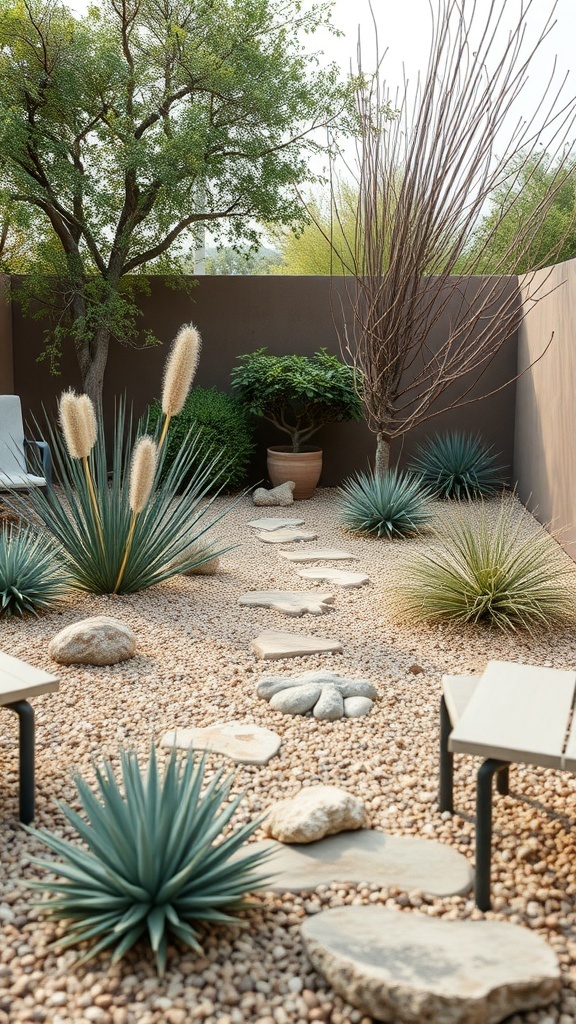
Dry garden design focuses on creating beautiful outdoor spaces that require minimal water. The image shows a well-planned dry garden with a variety of plants and stones. This setup not only looks appealing but also conserves water.
The pathway made of stepping stones guides the eye through the garden. It invites visitors to explore while keeping the design functional. The use of gravel and rocks reduces the need for grass, making maintenance easier.
Plants like succulents and cacti thrive in dry conditions. They add texture and color without needing much water. The trees and shrubs provide shade and create a balanced environment. This mix of elements shows how dry gardens can be both practical and attractive.
Incorporating native plants is another key principle. They are adapted to local climates and require less care. By choosing the right plants, you can create a sustainable garden that flourishes with little effort.
Overall, dry garden design is about harmony with nature. It emphasizes beauty while being mindful of resources. This approach can transform any space into a serene retreat.
Designing Pathways for Functionality and Aesthetics
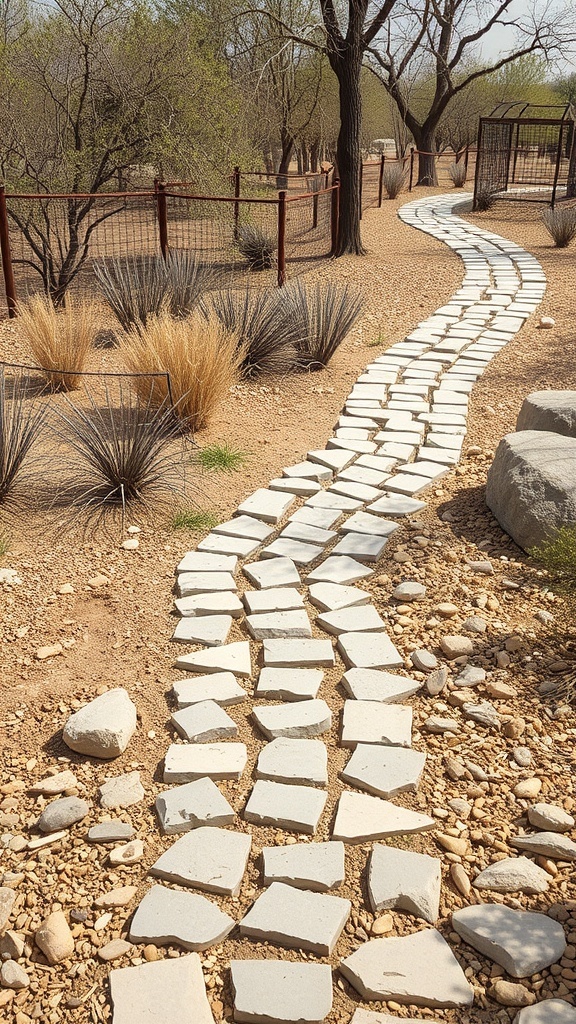
Creating pathways in a dry garden is all about blending function with beauty. The image shows a winding stone path that invites exploration while providing a practical route through the landscape. The stones are arranged in a way that adds a natural feel, making the garden look inviting.
Pathways like this one can guide visitors through different areas of the garden. They help keep the garden tidy and make it easier to navigate. The choice of materials, like the light-colored stones in the image, can contrast beautifully with the surrounding earthy tones, enhancing the overall look.
Incorporating curves in the pathway, as seen here, adds visual interest. Straight paths can feel rigid, while a meandering route encourages a more relaxed stroll. This design choice not only serves a practical purpose but also creates a sense of discovery as you move through the space.
Adding some surrounding plants, like the grasses in the image, can soften the edges of the path. This helps the pathway blend seamlessly into the garden, making it feel like a natural part of the landscape. Overall, a well-designed pathway can elevate the entire dry garden experience.
Creating Microclimates in Your Dry Garden
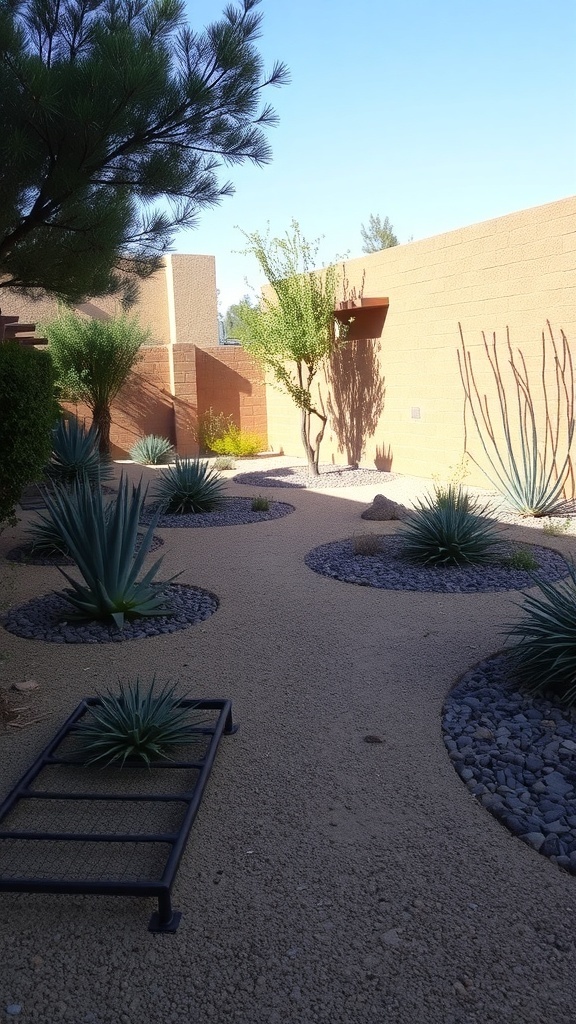
Microclimates can make a big difference in a dry garden. They create small areas with different conditions than the surrounding space. This can help plants thrive, even in tough environments.
In the image, you can see a beautifully designed dry garden. The layout features various plants, rocks, and gravel. This setup allows for different moisture levels and sunlight exposure. For instance, the taller plants provide shade, which can help lower temperatures in certain spots.
Using elements like walls and trees can also create sheltered areas. These spots can protect plants from harsh winds and direct sunlight. This is especially useful for delicate species that need a bit more care.
Consider adding features like boulders or raised beds. They can absorb heat during the day and release it at night, helping to regulate temperature. This is key for plants that prefer warmer conditions.
Overall, creating microclimates is a smart way to enhance your dry garden. It allows you to grow a wider variety of plants and keeps your garden looking vibrant and healthy.
Water Conservation Techniques for Dry Gardens
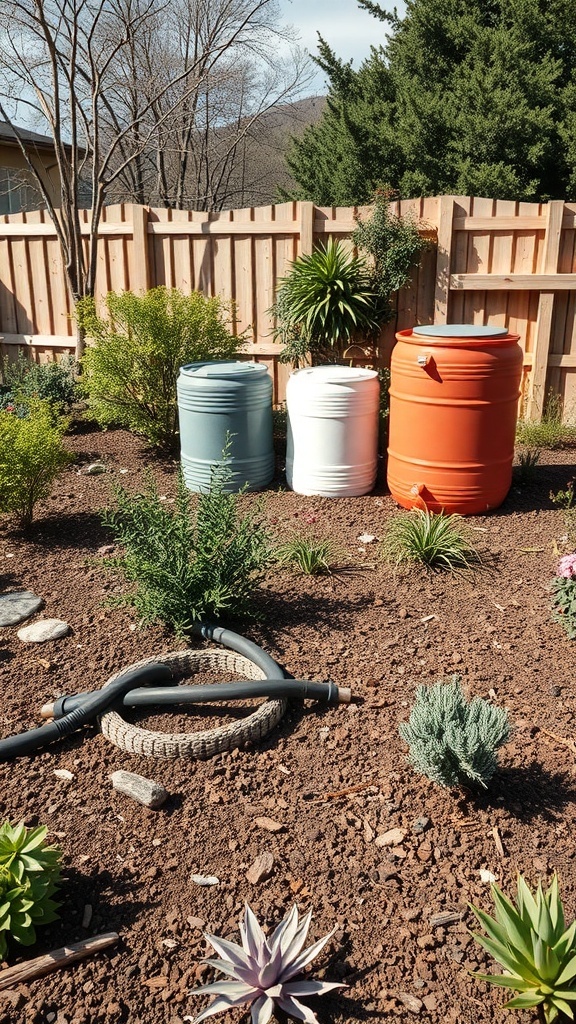
Creating a dry garden is a fantastic way to embrace sustainability while enjoying a beautiful outdoor space. The image shows a well-organized garden featuring colorful rain barrels, which are perfect for collecting rainwater. This technique is a simple yet effective way to conserve water.
Rain barrels can be placed under downspouts to catch rainwater from your roof. This water can then be used to hydrate your plants during dry spells. Using collected rainwater not only reduces your water bill but also helps in managing stormwater runoff.
In addition to rain barrels, consider using mulch in your garden beds. Mulch helps retain moisture in the soil and reduces the need for frequent watering. The dry garden in the image also features various drought-resistant plants, which thrive with minimal water. These plants are perfect for creating a low-maintenance garden that’s both attractive and eco-friendly.
Another great technique is to group plants with similar water needs together. This allows for more efficient watering and ensures that each plant gets the right amount of moisture. Overall, these water conservation techniques can make your dry garden not only beautiful but also sustainable.
Selecting Drought-Tolerant Plants for Your Space
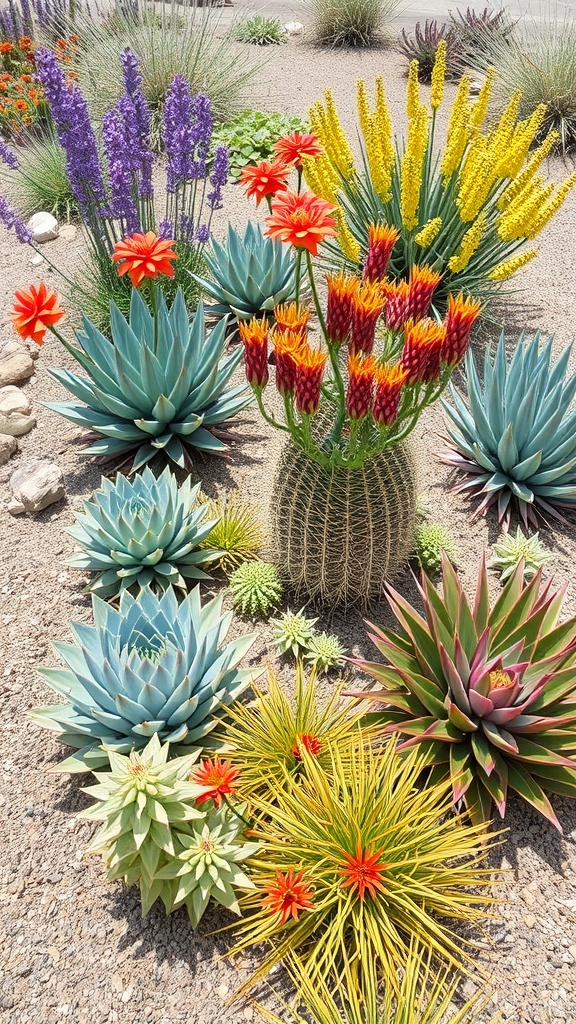
Creating a dry garden is all about choosing the right plants that thrive in low-water conditions. The image showcases a vibrant selection of drought-tolerant plants, featuring colorful flowers and unique foliage. These plants not only survive with minimal water but also add a beautiful touch to your outdoor space.
Look at the striking red and orange blooms that pop against the green and blue succulents. This combination brings life to the garden while being practical for dry climates. Plants like agave and various cacti are perfect choices, as they store water in their leaves and require little maintenance.
Incorporating these plants can make your garden both stunning and sustainable. Consider mixing different textures and colors to create visual interest. The purple flowers in the background add a lovely contrast, showing that drought-tolerant gardens can be colorful and inviting.
When selecting plants, think about your local climate and soil type. Some plants may thrive better in certain conditions than others. Researching native species can also lead to a successful and low-maintenance garden.
Incorporating Hardscape Elements in Dry Gardens

Hardscape elements play a key role in dry garden design. They add structure and interest while reducing the need for water. In the image, you can see a winding path made of stones and gravel. This creates a natural flow through the garden.
The use of different stone sizes adds texture and visual appeal. Larger rocks can serve as focal points, while smaller stones fill in gaps, making the path inviting. The gray gravel contrasts nicely with the sandy soil, enhancing the overall look.
Notice the playful sculpture of a dog in the background. This adds a whimsical touch to the garden, showing that hardscape can be functional and fun. Incorporating art pieces like this can bring personality to your space.
When designing your dry garden, think about how hardscape elements can guide movement and create a sense of place. Paths, stones, and sculptures can all work together to create a beautiful, low-maintenance landscape.
Seasonal Interest in Dry Gardens
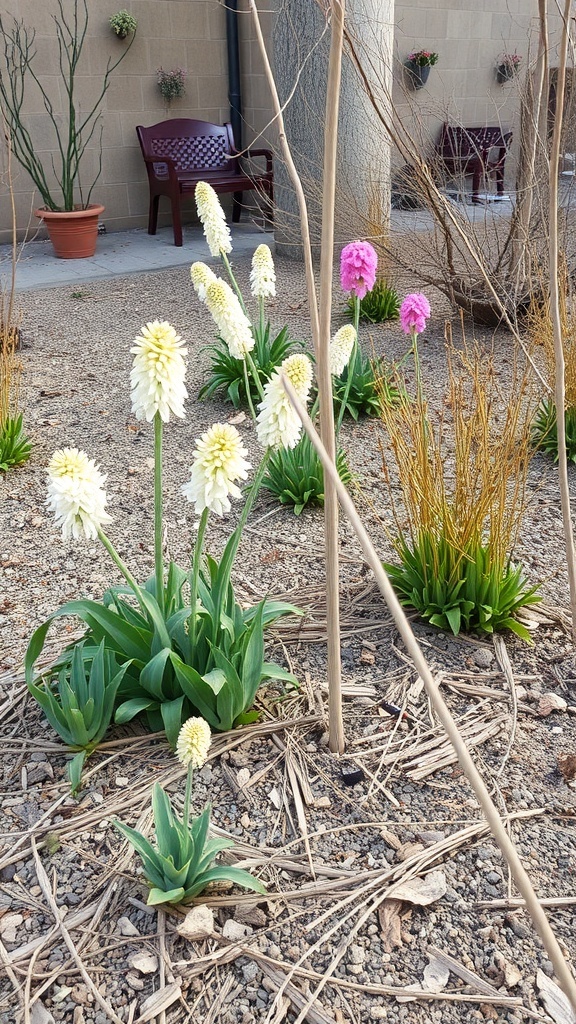
Dry gardens can be stunning throughout the year, showcasing a variety of plants that thrive in low-water conditions. In the image, you can see a mix of vibrant flowers and dry foliage. The white and pink blooms stand out against the earthy tones of the gravel and dried leaves.
These gardens often feature plants that bloom at different times, ensuring there’s always something to catch your eye. The tall, white flowers in the foreground add height and drama, while the pink flowers bring a splash of color. This combination creates a lively scene, even in a dry setting.
Incorporating seasonal plants can enhance the garden’s appeal. For instance, spring flowers like those shown can be paired with drought-resistant shrubs that provide structure during the summer months. This thoughtful planning keeps the garden looking fresh and inviting all year long.
Maintaining Your Dry Garden for Longevity
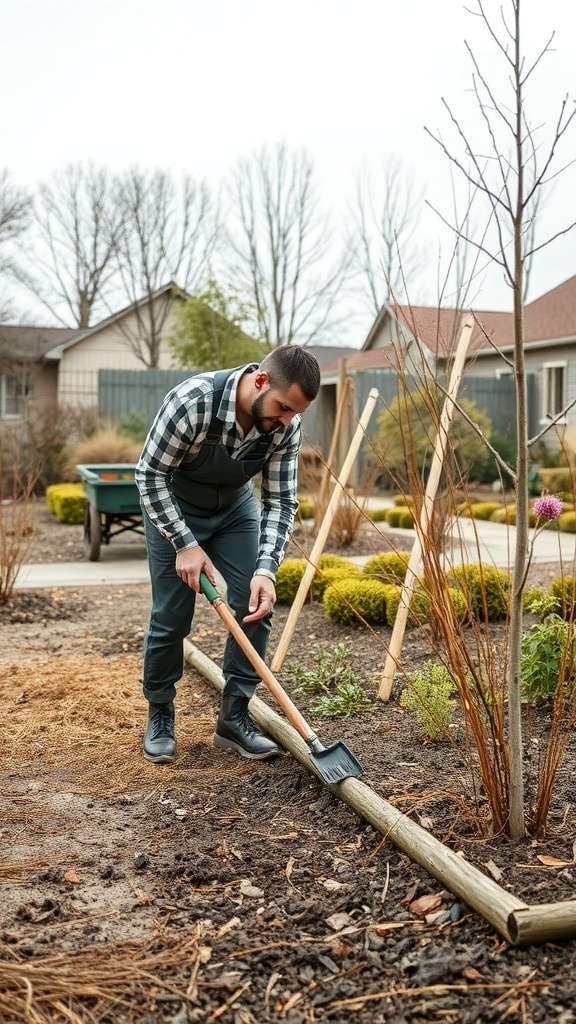
Maintaining a dry garden is all about keeping it healthy and vibrant with minimal water. In the image, a person is actively tending to the garden, using a shovel to work the soil. This hands-on approach is essential for ensuring that plants thrive in a dry environment.
Regular maintenance includes checking soil moisture and ensuring proper drainage. Mulching is a great way to retain moisture while suppressing weeds. The person in the image seems to be preparing the soil, which is a key step in promoting healthy plant growth.
It’s also important to choose the right plants. Drought-resistant varieties will flourish in dry conditions. The image shows a garden that likely features such plants, making it easier to maintain.
Lastly, seasonal care is vital. Pruning and removing dead plants can help prevent disease and encourage new growth. The gardener in the picture is clearly dedicated to this task, which is a great mindset for anyone looking to maintain a dry garden.
